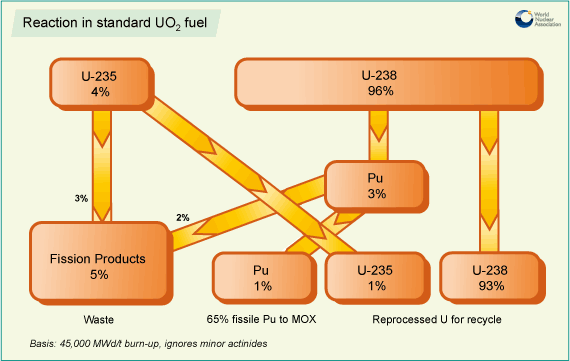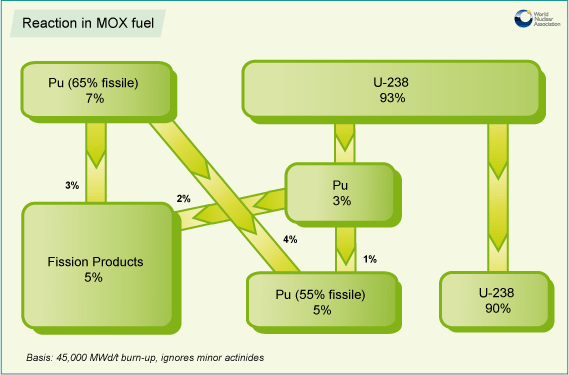|
from World-Nuclear Website
In every nuclear reactor there is both fission of isotopes such as uranium-235, and the formation of new, heavier isotopes due to neutron capture, primarily by U-238.
Most of the fuel mass in a reactor is U-238. This can become plutonium-239 and by successive neutron capture Pu-240, Pu-241 and Pu-242 as well as other transuranic isotopes (see page on Plutonium).
Pu-239 and Pu-241 are
fissile, like U-235. (Very small quantities of Pu-236 and Pu-238 are
formed similarly from U-235.)
The higher the burn-up, the
less fissile plutonium remains in the used fuel. Typically about one
percent of the used fuel discharged from a reactor is plutonium, and
some two thirds of this is fissile (c. 50% Pu-239, 15% Pu-241).
Worldwide, some 70 tonnes of plutonium contained in used fuel is
removed when refueling reactors each year.
A single recycle of plutonium in the form of MOX fuel increases the energy derived from the original uranium by
some 12%, and if the uranium is also recycled this becomes about 22%
(based on light water reactor fuel with burn-up of 45 GWd/tU).
Reaction in standard UO2 fuel Today there is a significant amount of separated uranium and plutonium which may be recycled, including from ex-military sources.
It is equivalent to about three years' supply of natural uranium from world mines.
In addition, there is about 1.6 million tonnes of enrichment tails,
with recoverable fissile uranium.
MOX use
So far about 2000 tonnes
of MOX fuel has been fabricated and loaded into power reactors. In
2006 about 180 tonnes of MOX fuel was loaded into over 30 reactors
(mostly PWR) in Europe.
These reactors generally use MOX fuel as about one third of their core, but some will accept up to 50% MOX assemblies. France aims to have all its 900 MWe series of reactors running with at least one third MOX.
Japan also plans to use MOX in one third of its reactors in the near future and expects to start up a 1383 MWe (gross) reactor with a complete fuel loading of MOX at the Ohma plant in late 2014.2
Other advanced light water reactors such as the EPR or AP1000 will be able to accept complete fuel loadings of MOX
if required.
Seven UO2 fuel assemblies give rise to one MOX assembly plus some vitrified high-level waste, resulting in only about 35% of the volume, mass and cost of disposal.
The
plutonium then needs to be separated from most or all of the
uranium. All this is undertaken at a reprocessing plant (see
information page on
Processing of Used Nuclear Fuel).
MOX fuel, consisting of about 7% plutonium mixed with depleted uranium, is equivalent to uranium oxide fuel enriched to about 4.5% U-235, assuming that the plutonium has about two thirds fissile isotopes. If weapons plutonium is used (>90% Pu-239), only about 5% plutonium is needed in the mix.
Areva has stated that
the plutonium content of commercial MOX fuel varies between 3 and
10% depending on the design of the fuel.
Reaction in MOX Fuel Plutonium from reprocessed fuel is usually fabricated into MOX as soon as possible to avoid problems with the decay of short-lived plutonium isotopes.
In particular, Pu-241 (half-life 14 years) decays to Am-241 which is a strong gamma emitter, giving rise to a potential occupational health hazard if separated plutonium over five years old is used in a normal MOX plant. The Am-241 level in stored plutonium increases about 0.5% per year, with corresponding decrease in fissile value of the plutonium.
Pu-238 (half-life 88
years), a strong alpha emitter and a source of spontaneous neutrons,
is increased in high-burnup fuel. Pu-239, Pu-240 and Pu-242 are
long-lived and hence little changed with prolonged storage. (See
also information page on
Plutonium).
(The plutonium isotopic composition of used MOX fuel
at 45 GWd/tU burn-up is about 37% Pu-239, 32% Pu-240, 16% Pu-241, 12%
Pu-242 and 4% Pu-238.)
One-third of the RepU is re-enriched and EdF has demonstrated its use in 900 MWe power reactors.
Also the Sellafield MOX Plant in UK was down-rated from 128 to 40 t/yr, although the plant has to date not been able to achieve anything close to its capacity. Japan is planning to start up a 130 t/yr J-MOX plant at Rokkasho in 2015.
Meanwhile, construction on a MOX fabrication facility at the
Savannah River Site in the USA is underway - see section below on MOX and disposition of weapons plutonium.) World mixed oxide fuel fabrication capacities (t/yr)
MOX is also used in fast neutron reactors in several countries, particularly France and Russia.
It was first developed for this
purpose, with experimental work being done in USA, Russia, UK,
France, Germany, Belgium and Japan. Today, Russia leads the way in
fast reactor development and has long-term plans to build a new
generation of fast reactors fuelled by MOX. The world's largest fast
reactor - the 800 MWe BN-800 - is currently under construction at Beloyarsk in the Urals and due to start up in 2010.
These stocks are expected to exceed 250 tonnes before they start to decline after 2010 as MOX use increases, with MOX then expected to supply about 5% of world reactor fuel requirements.
The Mixed Oxide Fuel Fabrication Facility (MFFF) at the Savannah River Site in the US state of South Carolina began construction in August 2007 and will convert the US plutonium to MOX fuel. Expected to begin operations in 2016, the MFFF is designed to turn 3.5 t/yr of weapons-grade plutonium into MOX fuel assemblies, which will be loaded at Duke Energy's Catawba and McGuire plants.
The contract to design, build and operate the MFFF was awarded to the Shaw AREVA MOX Services consortium in 1999, with the $2.7 billion construction option being exercised in May 2008.4
Four MOX fuel lead test
assemblies manufactured from US weapons plutonium and fabricated at
the Melox plant in France are being burned on a trial basis at the
Catawba plant.
Under this plan, Russia would begin disposition in the BN-600 reactor in the 2012 timeframe.
Disposition in the BN-800 would follow soon thereafter. Once disposition begins, the two reactors could dispose of approximately 1.5 t of Russian weapons plutonium per year. The USA agreed to contribute $400 million to the project.
The MOX fuel will be manufactured at a plant that is planned to be built at Tomsk, Siberia - though no firm plans for its construction currently exist.
In 2004 the first reprocessing of
used MOX fuel was undertaken on a larger scale with continuous
process. Ten tonnes of MOX irradiated to about 35,000 MWd/t and with
Pu content of about 4% was involved. The main problem of fully
dissolving PuO2 was overcome.
The program is described in the information page on Thorium.
With an estimated 150 tonnes of surplus
weapons plutonium in Russia, the thorium-plutonium project would not
necessarily cut across existing plans to make MOX fuel.
Further information
General sources
|


